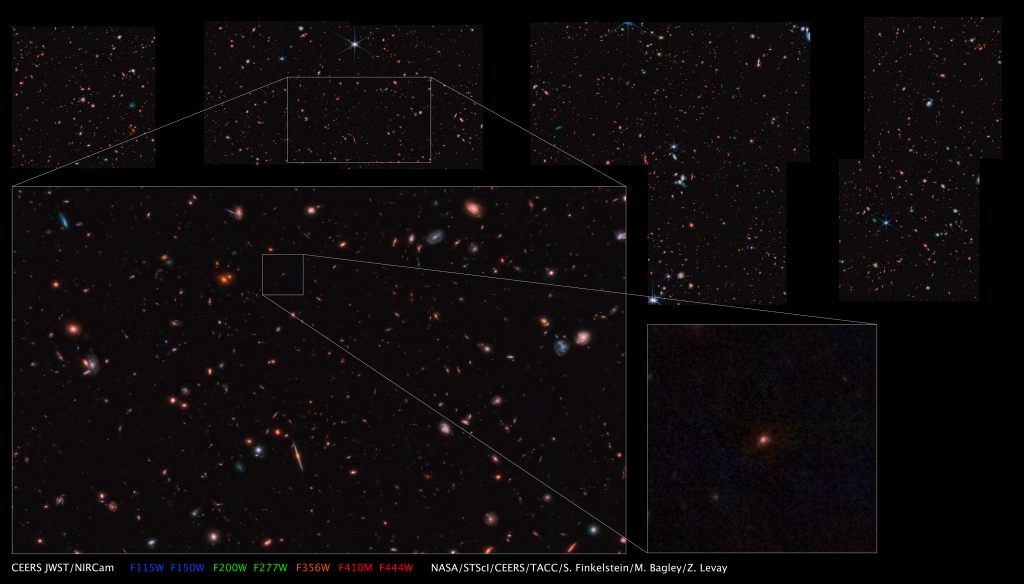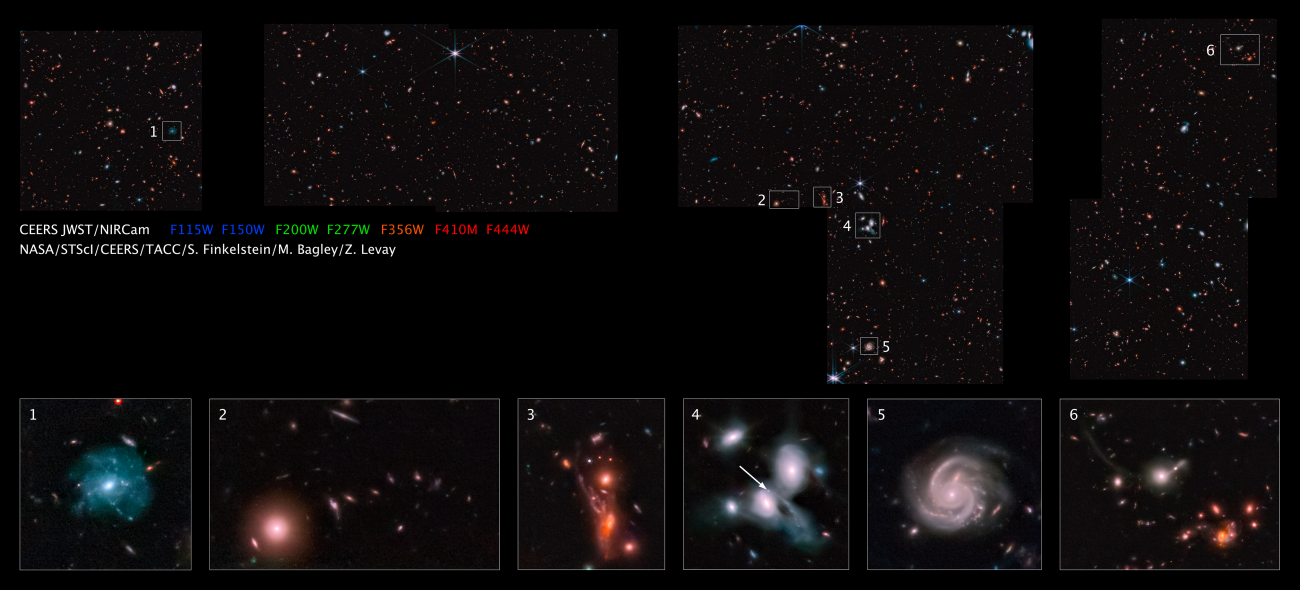Two new images from NASA’s James Webb Space Telescope show what may be among the earliest galaxies ever observed. Both images include objects from more than 13 billion years ago, and one offers a much wider field of view than Webb’s First Deep Field image, which was released amid great fanfare on July 12. The images represent some of the first out of a major collaboration of astronomers and other academic researchers teaming with NASA and global partners to uncover new insights about the universe.
UConn Department of Physics researchers associate professor Jonathan Trump and Ph.D. student Bren Backhaus are among the collaborators and they have eagerly awaited these images since the launch of the JWST last December.
Trump is a co-investigator “architect” within the large Cosmic Evolution Early Release Science Survey (CEERS) collaboration, and has worked to chair the science working group that studies the chemical enrichment of early galaxies. He explains the proposal behind the images was submitted five years ago, and after many delays in the launch of the telescope, the images are living up to the anticipation.
“It’s been a very long wait – but the data clearly show that it was absolutely worth it!” says Trump.

The team has identified one particularly exciting object—dubbed Maisie’s galaxy in honor of project head, and associate professor of astronomy at The University of Texas at Austin, Steven Finkelstein’s daughter—that they estimate is being observed as it was just 290 million years after the Big Bang (astronomers refer to this as a redshift of z=14).
The finding has been published on the preprint server arXiv and is awaiting publication in a peer-reviewed journal. If the finding is confirmed, it would be one of the earliest galaxies ever observed, and its presence would indicate that galaxies started forming much earlier than many astronomers previously thought.
The unprecedentedly sharp images reveal a flurry of complex galaxies evolving over time—some elegantly mature pinwheels, others blobby toddlers, still others gauzy swirls of do-si-doing neighbors. The images, which took about 24 hours to collect, are from a patch of sky near the handle of the Big Dipper, a constellation formally named Ursa Major. This same area of sky was observed previously by the Hubble Space Telescope, as seen in the Extended Groth Strip.
“JWST opens an entirely new window for understanding galaxies across cosmic time,” says Trump. “The crispness and depth of the images are incredible, and we can now see much more of the detailed structure of galaxies: spiral arms, knots of star clusters, and tidal tails thrown out by collisions between nearby galaxies. JWST’s infrared sensitivity — totally unmatched by any previous telescope — also gives us the first look at galaxies forming at cosmic dawn.”
This round of images has led to a flurry of “earliest galaxy” pre-print papers. Among those are one that Trump led that uses JWST observations to measure the gas conditions and chemical enrichment of galaxies as they grow in the first billion years of cosmic time. Another paper focuses on the difficulty of identifying early-galaxy candidates.
“The Universe starts out with only hydrogen and helium and every other element on the periodic table is slowly produced by nuclear fusion in stars and distributed by supernovae over the 13.7 billion years from the Big Bang to the current time. Our new paper finds that infant galaxies are surprisingly enriched by oxygen and other non-primordial elements, suggesting highly efficient stellar fusion and explosions in the early Universe,” says Trump.
The CEERS collaboration is composed of 18 co-investigators from 12 Institutions and more than 100 collaborators from the U.S. and nine other countries. CEERS researchers are studying how some of the earliest galaxies formed when the universe was less than 5% of its current age, during a period known as reionization.
“Being part of the CEERS collaboration allows us to get some of the first JWST data and gives new and exciting research opportunities. The JWST will help us answer questions about how our universe started,” says Backhaus, who says this is such an exciting time to be a graduate student in this field. “For example, our collaborator Steve Finkelstien puts it best saying how exciting and important JWST is for completing our ‘ultimate human origin story’: not just how did our species, planet, or Solar System come to be, but this field seeks the answer to how our Milky Way Galaxy came to be.”
The large image (medium res/high res) is a mosaic of 690 individual frames that took about 24 hours to collect using the telescope’s main imager, called the Near Infrared Camera (NIRCam). This new image covers an area of the sky about eight times as large as Webb’s First Deep Field image, although it is not quite as deep. Researchers used supercomputers at the Texas Advanced Computing Center for the initial image processing: Stampede2 was used to remove background noise and artifacts, and Frontera, the world’s most powerful supercomputer at a university, was used to stitch together the images to form a single mosaic.
The other image (medium res) was taken with the Mid-Infrared Instrument (MIRI). Compared with NIRcam, MIRI has a smaller field of view but operates at much higher spatial resolution than previous mid-infrared telescopes. MIRI detects longer wavelengths than NIRCam, allowing astronomers to see cosmic dust glowing from star-forming galaxies and black holes at modestly large distances, and see light from older stars at very large distances.
The entire CEERS program will involve more than 60 hours of telescope time. Much more imaging data will be collected in December, along with spectroscopic measurements of hundreds of distant galaxies.
“With all this new data comes a wealth of information, which could be overwhelming. Luckily with a large collaboration like this there’s always an expert to explain the topic and to help with your understanding,” says Backhaus.
NASA’s James Webb Space Telescope is a partnership with ESA (European Space Agency) and CSA (Canadian Space Agency). Additional co-investigators in CEERS are Henry Ferguson, Norman Grogin, Anton Koekemoer, Nor Pirzkal and Swara Ravindranath of the Space Telescope Science Institute; Mark Dickinson of NSF’s NOIRLab; Andrea Grazian of INAF – Osservatorio Astronomico di Padova; Jeyhan Kartaltepe of the Rochester Institute of Technology; Lisa Kewley of the Harvard-Smithsonian Center for Astrophysics; Dale Kocevski of Colby College; Jennifer Lotz of the Gemini Observatory; Casey Papovich of Texas A&M University; Laura Pentericci, INAF – Osservatorio Astronomico di Roma; Pablo G. Pérez-González of Centro de Astrobiología; Rachel Somerville of the Flatiron Institute; Steven Finkelstein of The University of Texas at Austin; and Stephen Wilkins of the University of Sussex.



